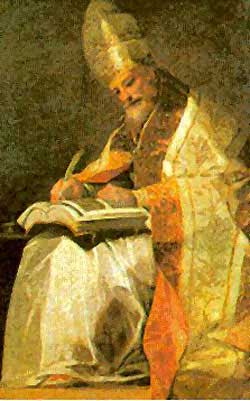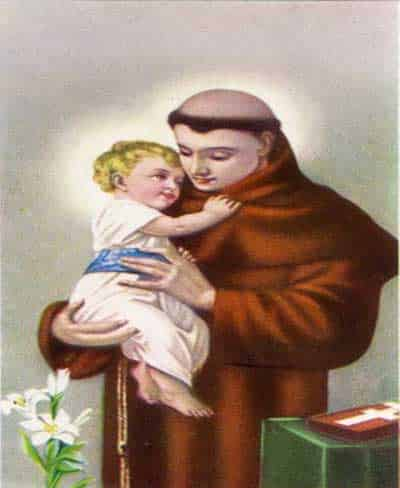st.Gregory VII-Pope
CATHOLIC SAINTS 28-12-2023, 19:38

Feast Day : May 25
Also known as: Hildebrand, Holy Satan
Gregory was highly influential in the Roman Church even before his elevation to the papacy. He was largely responsible for changing the rules for selecting popes from election by all the Christians of Rome to election by the College of Cardinals. The widespread reforms he instituted during his own reign won him the perverse epithet, “Holy Satan.” However, he is recognized today as one of the greatest popes of the Middle Ages. Gregory was born in Ravaco, near Saona, in Tuscany, Italy, around 1021. His father was a poor peasant, perhaps a carpenter, named Bonizo. He was baptized Hildebrand (Hellebrand). While still a youth, he was placed in the care of his uncle Laurentius, superior of the monastery of Santa Maria in Rome. He joined the Benedictine order and was educated at the Lateran Palace school, where one of his teachers was John Gratian, the future pope (or antipope) Gregory VI (r. 1045–46). When Gratian was elected pope in May 1045, he made Hildebrand his secretary, and when he was deposed the following December, Hildebrand followed him into exile in Cologne, Germany. After Gratian died in 1047, Hildebrand moved to Cluny, where he resumed the monastic life. It was there, in January 1049, that he met Bruno, Bishop of Toul, then recently elected Pope St. Leo IX (r. 1049–54), who took him back to Rome. Leo created Hildebrand a cardinal-subdeacon and made him administrator of the Patrimony of St. Peter’s. Under Hildebrand’s leadership, much Church property was recovered and the revenues of the Holy See increased. Leo then appointed him propositus of the monastery of St. Paul-Outside-the-Walls, which had lost much of its monastic discipline. Women attended the monks in its refectory, and sheep and cattle roamed freely through the broken doors of its sacred buildings. Under Hildebrand’s direction, the monastery’s austerity was restored. In 1054, Leo sent Hildebrand as his legate to the Council of Sens. He was still in France when news came of Leo’s death, and he hurried back to Rome. There was talk of electing him pope, but he worked to secure the election of Victor II (r. 1055–57) instead. Under Victor, Hildebrand continued to work behind the scenes. After Victor, he was instrumental in the elevation of Popes Stephen (r. 1057–58) and Nicholas II (r. 1058–61). During Nicholas’s reign, he engineered the papal decree overturning the traditional manner of electing popes and mandating the College of Cardinals as the electoral body. He was also responsible for negotiating the 1059 Treaty of Melfi, which allied the Roman Church with the Normans. Alexander made him archdeacon and appointed him chancellor of the Apostolic See. When Alexander died in June 1073, Hildebrand himself was elected pope by an overwhelming majority. He was consecrated on June 30, took the name Gregory VII, and immediately set about his widest reforms to date. He convened councils in Rome in 1074 and 1075 at which he enacted decrees against married clergy, simony and the royal investiture of bishops and abbeys. A council convened in Paris in response declared the decrees to be intolerable, but Gregory enforced them through depositions and excommunications. Gregory’s reforms made him many enemies and found a varied response in Europe. The most intractable region turned out to be Germany, then under the rule of Henry IV. Henry had Gregory kidnapped by Roman nobles while he was celebrating a Christmas Eve midnight Mass in St. Mary Major’s, and he was held for several hours before being rescued by parishioners. This was only the beginning, however, for Henry tried to have Gregory deposed, whereupon Gregory excommunicated Henry. Gregory lifted the excommunication when Henry repented, but reinstated it in 1080 when Henry reneged on his promises. Henry then invaded Italy and attacked Rome, taking it in 1084 and forcing Gregory to take refuge in the Castle Sant’ Angelo. Henry demanded that Gregory crown him emperor, but when the pope refused, Henry thew his support behind Guibert, archbishop of Ravenna. Guibert was duly consecrated as antipope Clement III, and in turn crowned Henry. Gregory remained at Sant’ Angelo until he was rescued by Robert Guiscard, the Norman duke of Calabria, whom he had summoned to his aid. Unfortunately, in retaking Rome from Henry, the Normans sacked the city, which added to Gregory’s growing unpopularity, since he was seen as responsible for the pillaging. He fled to Monte Cassino and then to Salerno, having been abandoned by 13 of his cardinals. Gregory’s health began to decline and he died in Salerno on May 25, 1085. On his deathbed, he forgave his enemies and withdrew all his censures and excommunications except those against Henry and Guibert. His body was interred in the church of St. Matthew at Salerno. In art, Gregory is shown as a pope holding a book and ring or with the Virgin and Child, from whom a ray of light shines and pierces his heart, while a dove rests on his shoulder. He has also been depicted being driven from Rome by soldiers.

Christmas Wishes-Gifts under the Christmas tree HD wallpapers Download There are many gifts under the...
Learn more
Matthew 5:48 Bible Quotes HD-Wallpaper Download You, therefore, must be perfect, as your heavenly Father is...
Learn more
Italian Bible Quotes Mobile Wallpaper Proverbs 3:6 Download Proverbs 3:6 Italian Bible Quotes Mobile...
Learn more 0


